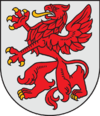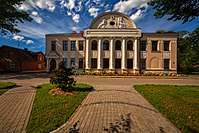Jaunjelgava
Jaunjelgava (![]()
Jaunjelgava Friedrichstadt; Neustadt | |
|---|---|
Town | |
 Coat of arms | |
 Jaunjelgava Location in Latvia | |
| Coordinates: 56°36′N 25°5′E | |
| Country | |
| District | Jaunjelgava municipality |
| Town rights | 1647 |
| Area | |
| • Total | 6.1 km2 (2.4 sq mi) |
| • Rural territory | 5.1 km2 (2.0 sq mi) |
| Population | |
| • Total | 2,245 |
| • Density | 440/km2 (1,100/sq mi) |
| Time zone | UTC+2 (EET) |
| • Summer (DST) | UTC+3 (EEST) |
| Postal code | LV-5134 |
| Calling code | +371 651 |
| Number of city council members | 9 |
| Website | http://www.jaunjelgava.lv |
History
There is no evidence that territory of a modern Jaunjelgava had been inhabited before 15th century. However a selonian Sērene hillfort existed 5 km from the modern town. A country estate Vecsērene manor was established around 1450 not far from modern town. During the 15th century territory of the town was used as a place where merchants from Riga transported their goods from boats to carriages because, due to Daugava rapids, it was hard to navigate further downstream. As a result, a small port emerged.
In 1567 Duke of Courland and Semigallia Gotthard Kettler called the small port as Neustadt. In 1590 next Duke Friedrich Kettler founded the town market and granted village rights to Neustadt. At that time about 60 families lived at the town. The village was devastated in 1621, during the Polish-Swedish war, and was re-established as a town in 1646 when widow of the Friedrich Kettler Elisabeth Magdalena of Pomerania in honour of her husband gave new name to the town – Friedrichstadt. In 1647 king of Poland Władysław IV granted town rights and approved Coat of arms of Friedrichstadt. In 1652 lutheran church was built in the town by order of duke Jacob Kettler. Town saw rapid development in the second half of the 17th century when after Second Northern War town was important transport hub.
In 1710 the plague epidemic started. Also there was several large fires in the town during 18th century. Also great damage was inflicted by four big floods. Biggest of them was in 1778 when around 100 houses were destroyed. In 1795 Friedrichstadt as a part of Duchy Of Courland and Semigallia was incorporated into Russian Empire and became part of Courland Governorate. During 1812 Napaleon's invasion in Russia several small battles was fought around the town. In 1831 and 1848 cholera, raged. During first half of the 19th century town prospered thanks to merchant activities. Local inhabitants owned warehouses, taverns for rafters and was involved in transportation of goods by carriages to Jacobstadt. In 1820 there were 24 taverns in the town.
After opening of the Riga–Daugavpils Railway line in 1861, the Daugava River waterway, and thus the city, lost its importance. However in the late 19th century there were still around 10 banks and various insurance offices, 60 merchant enterprises, 23 industrial enterprises and a hospital in the town. In 1909 telephone connection was established between Friedrichstadt, Riga and Jelgava. In 1914 the city had 7,300 inhabitants.
During Latvian War of Independence town was heavily damaged when in 1919 from October 17 to November 15 heavy fighting took place near the city. At the battle end town was liberated by Latvian army from West Russian volunteer army. In 1925 the city had only 1577 inhabitants.[1] During Republic of Latvia town was renamed Jaunjelgava (literary: New Jelgava). In 1930s 3.5 km long and 3 m. high dam was constructed to protect town from floods.
Shtetl
Jaunjelgava was one of many shtetls which once existed in the Pale of Settlement. Its Jewish community was established toward the close of the seventeenth century. In 1858 first Jewish school was opened in the town. In 1897, 3,800 of its population of 5,223 were Jews.[2] By 1935, only 25% of the city's population was Jewish. Some of them were deported in June 1941, and some perished in the Holocaust when on August 2 German troops liquidated the city's Jewish community.
Jaunjelgava municipality
In 2009 the city joined six surrounding communities to form a local government district. (See also: Administrative divisions of Latvia)
Selected publications
- Heinz zur Mühlen: Baltisches historisches Ortslexikon, Tl. 2, Lettland (Südlivland und Kurland), ISBN 978-3-41206-889-9
- Latvijas Pagastu Enciklopēdeija, 2002, ISBN 9984-00-436-8
- Friedrichstadt entry in the Jewish Encyclopedia
See also
- List of cities in Latvia
Photo gallery
 Jaunjelgava town hall
Jaunjelgava town hall- Sculpture of a lion, the symbol of Jaunjelgava
- Daugava River
- Jaunjelgava's Orthodox church
- Jaunjelgava's Catholic church
- Bus stop
References
- Encyclopedia "Latvian cities". Rīga 1999.
- Friedrichstadt entry in the Jewish Encyclopedia